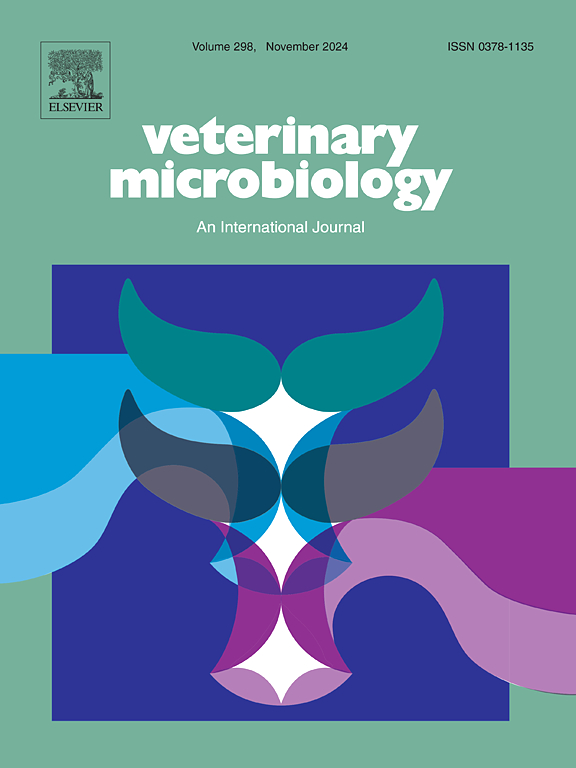意大利北部奶牛和绵羊皱胃幽门杆菌的分子、病理和免疫组化研究。
IF 2.7
2区 农林科学
Q3 MICROBIOLOGY
引用次数: 0
摘要
虽然有几种幽门螺杆菌与人类和动物的胃病有关,但它们在家养反刍动物中的作用尚不清楚。本研究旨在调查意大利北部饲养的奶牛和绵羊瘤胃中幽门螺杆菌、“牛候选杆菌”和其他幽门螺杆菌科的流行情况,以阐明它们作为人类幽门螺杆菌潜在宿主的作用,并评估幽门螺杆菌在这些动物胃病理中的作用。屠宰时从25头奶牛和24只羊中采集了阿波马萨。在宏观检查后,通过筛选PCR检测幽门杆菌,随后进行特异性PCR(幽门螺杆菌,“牛候选菌”和Wolinella spp),组织学检查和幽门螺杆菌免疫组化。总体而言,96% %的牛和42% %的羊乳腺检测出幽门螺杆菌阳性。没有样品检测出幽门螺杆菌阳性,而68% %的牛样品检测出“牛候选菌”阳性,主要在幽门黏膜。免疫组化结果显示,幽门螺杆菌仅在11只(44. %)牛的幽门腺中定植,而在绵羊的幽门螺杆菌中未发现定植。我们的结果证实了“Candidatus H. bovis”是牛皱胃中最常见的幽门杆菌科,并特异性定植于牛幽门腺体。幽门螺杆菌感染状态与胃粘膜炎症无关联,提示幽门螺杆菌对牛宿主有高度的适应性。牛羊作为人类幽门螺杆菌潜在来源的作用似乎可以忽略不计。本文章由计算机程序翻译,如有差异,请以英文原文为准。
Molecular, pathological and immunohistochemical investigation of Helicobacteraceae in the abomasum of dairy cattle and sheep in Northern Italy
Although several Helicobacter species have been associated with gastric disease in humans and animals, their role in domestic ruminants is still unclear. This study aimed to investigate the prevalence of H. pylori, “Candidatus H. bovis” and other Helicobacteraceae in the abomasum of dairy cattle and sheep reared in Northern Italy, to shed light on their role as potential reservoir of H. pylori for humans and to evaluate the involvement of Helicobacter spp. in the gastric pathology of these animal species. Abomasa from 25 dairy cows and 24 sheep were collected at slaughter. Following macroscopic examination, samples of fundic and pyloric mucosa were analysed by a screening PCR for Helicobacteraceae, followed by specific PCRs (H. pylori, “Candidatus H. bovis”, and Wolinella spp.), histological examination, and immunohistochemistry for Helicobacter spp. Overall, 96 % of the bovine and 42 % of the ovine abomasa tested positive for Helicobacteraceae. No samples tested positive for H. pylori, while 68 % of bovine samples tested positive for “Candidatus H. bovis”, mostly in the pyloric mucosa. Immunohistochemistry showed colonisation by Helicobacter spp. only in the pyloric glands of 11 bovine abomasa (44 %), while in ovine abomasa colonisation was not detected. Our results confirmed that "Candidatus H. bovis" is the most common Helicobacteraceae in the bovine abomasum and specifically colonises bovine pyloric glands. No association was found between Helicobacter spp. infection status and abomasal inflammation, suggesting a high degree of adaptation to the bovine host. The role of cattle and sheep as potential source of H. pylori for humans appears to be negligible.
求助全文
通过发布文献求助,成功后即可免费获取论文全文。
去求助
来源期刊

Veterinary microbiology
农林科学-兽医学
CiteScore
5.90
自引率
6.10%
发文量
221
审稿时长
52 days
期刊介绍:
Veterinary Microbiology is concerned with microbial (bacterial, fungal, viral) diseases of domesticated vertebrate animals (livestock, companion animals, fur-bearing animals, game, poultry, fish) that supply food, other useful products or companionship. In addition, Microbial diseases of wild animals living in captivity, or as members of the feral fauna will also be considered if the infections are of interest because of their interrelation with humans (zoonoses) and/or domestic animals. Studies of antimicrobial resistance are also included, provided that the results represent a substantial advance in knowledge. Authors are strongly encouraged to read - prior to submission - the Editorials (''Scope or cope'' and ''Scope or cope II'') published previously in the journal. The Editors reserve the right to suggest submission to another journal for those papers which they feel would be more appropriate for consideration by that journal.
Original research papers of high quality and novelty on aspects of control, host response, molecular biology, pathogenesis, prevention, and treatment of microbial diseases of animals are published. Papers dealing primarily with immunology, epidemiology, molecular biology and antiviral or microbial agents will only be considered if they demonstrate a clear impact on a disease. Papers focusing solely on diagnostic techniques (such as another PCR protocol or ELISA) will not be published - focus should be on a microorganism and not on a particular technique. Papers only reporting microbial sequences, transcriptomics data, or proteomics data will not be considered unless the results represent a substantial advance in knowledge.
Drug trial papers will be considered if they have general application or significance. Papers on the identification of microorganisms will also be considered, but detailed taxonomic studies do not fall within the scope of the journal. Case reports will not be published, unless they have general application or contain novel aspects. Papers of geographically limited interest, which repeat what had been established elsewhere will not be considered. The readership of the journal is global.
 求助内容:
求助内容: 应助结果提醒方式:
应助结果提醒方式:


